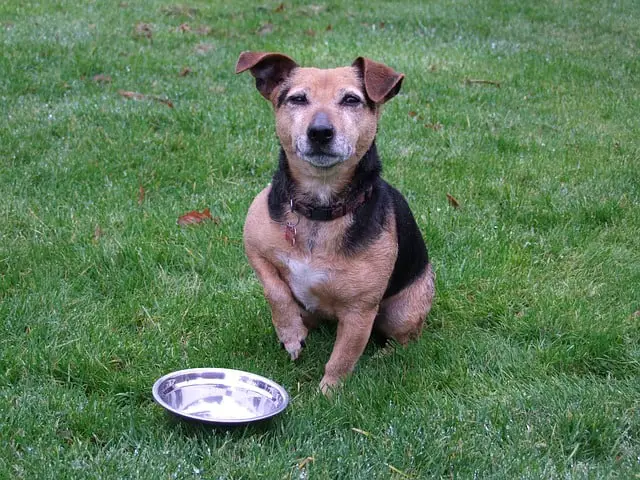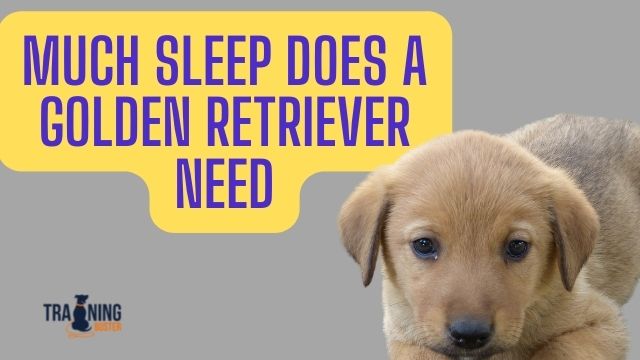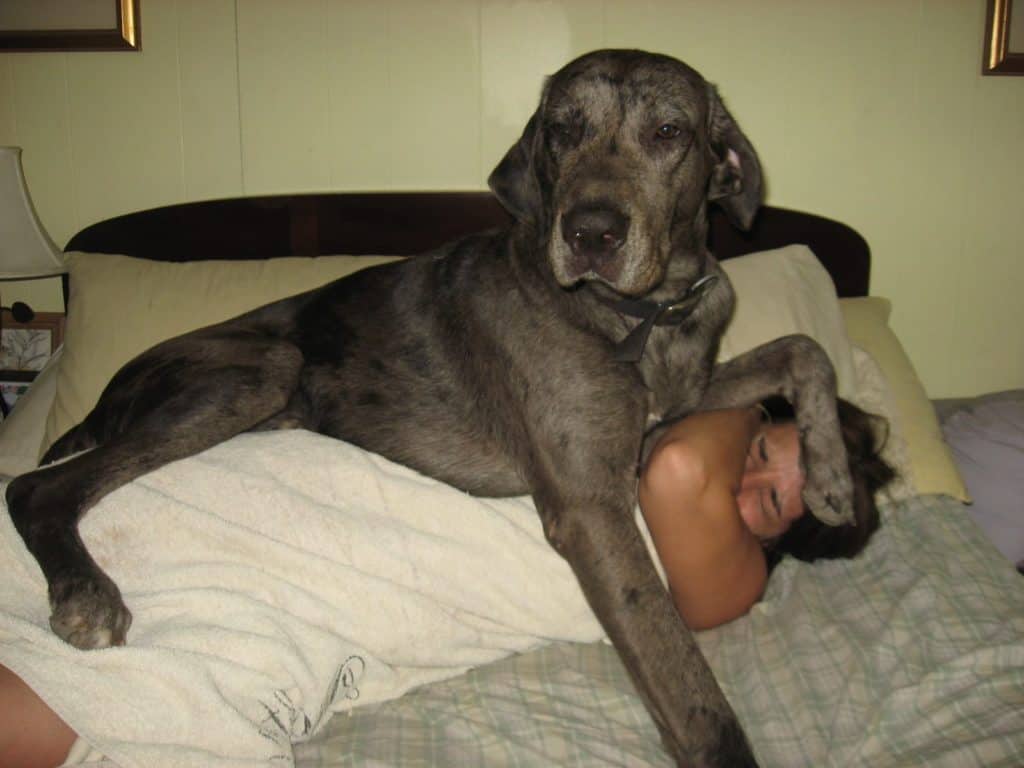
Want to know how much food you should give to a small dog find out in this article?
Using an 8oz measuring cup, measure 1/3 of a cup of food for every 10 pound’s of your dog’s body weight. Puppy’s and nursing dogs may require more.
The health of your dog can be directly traced to his feeding habits and daily schedule.
Feeding just the right amount of food is vital to your dog’s overall well being and cannot be overlooked.
Too little and your dog can suffer from nutritional deficiencies. Too much and it might result in obesity, bringing with it a host of health problems.
There is a lot of contention among dog owners about what you should feed your dog and how much. Unfortunately, there is no easy way to figure this out. There is no universal manual that can be applied to dogs.
Since dogs vary by breed, they have considerable physical and metabolic differences and therefore different dietary needs.
Determining the correct size of meals would depend on the size of your dog, his overall weight, age, metabolic rate and amount of exercise they get.
If you’re using a commercial pet food, beware of the “feeding guidelines” on the bag or box.
It lists different weights and the relating measure of nourishment to encourage your pooch to keep up that weight, and ought to be utilized just as a harsh rule.
Numerous puppies are overweight on the grounds that their families intently pursued the headings on the back of the food pack, which regularly shows meal sizes that are excessively substantial.
All things considered, the sooner the sack is unfilled, the sooner you should purchase more sustenance. Beginning at the low end of the recommended rules and afterward observing your puppy for appetite and body condition is a decent approach.
General Feeding Guidelines for a small dog
For the first six to eight weeks of a puppy’s life, he should be with his mother and nurse as he pleases. The mother’s milk provides the nutrients necessary to protect the puppy from diseases.
During this time you don’t need to worry as much about how much to feed puppy because his mother is the one feeding him.
Once your puppy has hit the four to six week age you should start to wean him off his mother’s milk — this will take two to three weeks. To do this, select a brand of puppy food — consider asking your vet for any recommendations.
Blend the dog food with milk replacer and offer it to the puppy three to four times a day. Gradually reduce the amount of milk replacer until you’re only giving him dog food, the puppy should be around eight weeks old.
On average, puppies and young dogs burn more calories, so they need a greater quantity of food that is higher in protein and fat.
Puppies require an eating routine that is higher in protein and different supplements to help ordinary development and advancement. On the off chance that you are feeding commercial pet food to your pup, select a brand that caters exclusively to puppies.
Puppies ought to be sustained at least three times each day — morning, noon, and an early night — until their sustenance necessities per pound of body weight start to level off as they develop.
When the dog is one year of age, his sustaining timetable can be diminished to two times per day. In the event that you have a finicky dog, you can add some warm water to dry food to urge him to eat it.
Cow milk can act as a laxative and cause stomach related issues for a few young doggies and grown-up mutts, so abstain from offering this to your dog or just give little sums. In the event that your dog doesn’t eat all his or her food within the hour, dispose of the uneaten portion.
The measure of nourishment you feed your young dog will shift contingent on his size, movement, digestion, and condition. Sustaining excessively can prompt a thick little guy, as well as cause bone deformities and other medical problems.
If your dog appears to be gaining too much weight, gradually decrease his food intake, but if his ribs are showing, increase his portions. If you are unsure about his proper weight or appearance, talk to your vet for guidance.
At the point when the normal pooch is one year old, he has achieved full development and enters a “support period.” This implies his nourishing necessities will remain about the equivalent amid his young grown-up life, expecting he isn’t sick or participating in outrageous physical exercise.
How much food to give a small dog by weight. (basic guide)
| 3 Pound dog | 1/3 Cup |
| 6 Pound dog | 1/2 Cup |
| 10 Pound dog | 3/4 Cup |
| 15 Pound dog | 1 Cup |
| 20 Pound dog | 1 2/3 Cup |
His weight ought to stay stable and his body should be proportional — he ought to have a discernible midriff and you ought to be able to feel his ribs with your fingertips, underneath a thin layer of fat.
If you are feeding your adopted adult dog commercial pet food, select one that is specially formulated for adult dogs. Similarly as with people, a pooch’s craving may shift from day to day.
This isn’t reason to worry except if his loss of hunger holds on for a few days or he hints at clear weight reduction or disease.
Nonetheless, wanting to eat can be the principal indication of numerous sicknesses, so screen your puppy’s food intake cautiously. You know your dog best, so if something seems amiss, don’t hesitate to take him to his vet.
Moderate exercise is fundamental for all pooches and causes them stay healthy all through their lifetime. In any case, a few puppies, similar to a few people, will routinely do more intense exercising.
In the event that your puppy is especially dynamic (for example, in the event that he runs or keeps running with you routinely, or is associated with brandishing exercises) his vitality needs will be more prominent than those of his increasingly inactive partners.
Know, however, when a commonly dynamic pooch is less active (for example, amid the virus winter months or when he endures injury, for example, a sprain or muscle pull), his food requirements decrease.
In these instances, experts recommend gradually changing to lower energy, less nutrient-dense dog food. Exceptionally dynamic canines ought not to be fed preceding or following a strenuous exercise.
This can prompt digestion problems or discomfort, (for example, vomiting or loose motion) and may build the danger of gastric swell, a difficult and frequently hazardous condition brought about by a twisting of the stomach.
Although a small meal can be provided in the morning, hard-working dogs should receive the bulk of their daily calories one hour or more following their last exercise session each day.
You can likewise nourish your pooch little tidbits or treats amid times of expanded action to avert craving and exhaustion. Enable him to rest intermittently and ensure he has access to water at all times.
Similarly as is with people, the dietary necessities of dogs will change as they age.
Old dogs have diminished vitality necessities and therefore shouldn’t expend the same amount of food from they did when they were more youthful.
In case you’re feeding your adopted senior canine commercial pet food, search for brands that offer decreased calories while as yet including all the important supplements. Senior dogs, like all dogs, should be fed according to their overall health and level of activity. A less active dog can quickly gain weight if you’re not careful.
What is the best time to feed your dog?
The ideal time to feed a dog is early morning around 7 am, Then again in the evening at around 5 pm. Try to be consistent with the time and get into a routine.
Experts say you should feed your dog twice a day and puppy’s three times a day maybe more.
What Is the Best Wet and Dry Dog Food Ratio Plus Tips
When mixing dry and wet dog food it all comes down to your own personal choice. I do a 50/50 mix. There is no right or wrong amount. Another common ratio is 2/3rds kibble and 1/3 topper.
You should be looking for a well balanced diet, So adding some left over greens or fish will add some vitamins,
My to tips are:
Tip 1 – Try mixing different shapes, sizes, and smells to give a balanced flavor and texture.
Tip 2 – If you are just using dry kibble try mixing some water or adding canned fish like Tuna or Sardines. Or some fish oil like this one for dogs your dog will love it
Tip 3 – Add a few drops of Hemp oil into the food. Hemp oil has many Vitamins and fatty acids. Here is my favorite.
Tip 4 – Add some Digestive Enzymes, its digestion aid for canine digestive & gastrointestinal health. You can find it on Amazon here.
Basic Feeding Tips.
- Dogs should be fed at the same time every day. Feeding at the same time will keep your dog on a bathroom schedule. Ask your vet how many times a day you should feed your dog.
- Feed your dog the same type and brand of food every day. Unlike humans, a dog’s digestive system cannot handle changes in food. It can cause an upset stomach and diarrhea.
- When switching to a new food gradually transition him to the new food by mixing portions of both foods until you slowly phase out the old food. Your dog may experience diarrhea if his food is suddenly changed.
- If you are mixing water into dry food you should mix 4 parts dry food to 1 part water.
- Keep fresh drinking water available at all times. Change the water at least once a day, more for dogs who drool.
- Keep food and water bowls clean.
- Don’t overfeed your dog.
- Monitor your dog’s weight and activity level, and make feeding adjustments as necessary.
Related Questions.
How much should I feed my dog if he’s inactive?
Inactive dogs need fewer calories, not necessarily less food. So you can go one of two ways from this point.
You can feed him less food (say 2.2 – 2.5% of his body weight per day) or you could feed him the same size meal as a normal dog but you need to make sure his meals are lean (use white meats like chicken/turkey/fish instead of fattier red meats).
How much should I feed my dog if he’s very active?
You need to feed active dogs a little more food (at least 3% of his body weight) or feed a higher calorie (fattier) meal! So opt for red meats over white!
How much should I feed my puppy?
Puppies eat a lot more in terms of a percentage of their body weight. On average, a pup of a medium-sized dog will be eating around 10% of his body weight at 2 months of age, 5% of his body weight by 6 months and 3% of his body weight by a year.
Can puppies eat adult dog food?
Puppies and adult dogs have different nutrient needs. To help puppies grow into adult dogs, they require more protein, micronutrients and carbs. Puppies also require a high amount of calories to help them grow, so it’s important to purchase a high-quality brand of food for your puppy.
A puppy’s mouth is smaller than an adult’s, which helps explain why their food is smaller too.
Feeding them adult dog food can be dangerous because the kibbles are larger and the texture is harder. If you give a puppy adult dog food, it can cause damage to his teeth, jaws and overall health.


